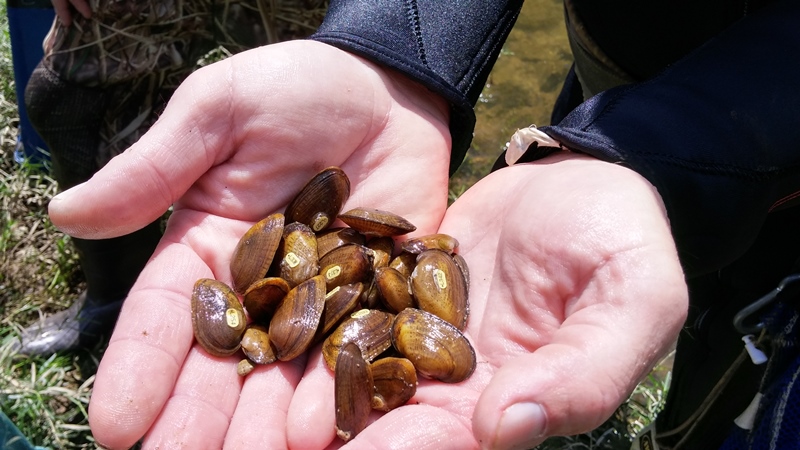|

Contact: Tom Blount, 423-569-9778 Contact: Niki Stephanie Nicholas, 423-569-9778 Three species of federally protected freshwater mussels (Cumberlandian Combshell, Tan Riffleshell, and Littlewing Pearly Mussel) were released in a Kentucky section of the Big South Fork of the Cumberland River on Wednesday, August 12. All three of these species used to be found throughout the river. The Big South Fork National River and Recreation Area has worked collaboratively with the U.S. Fish and Wildlife Service and Kentucky Department of Fish and Wildlife Resources to reach this important ecological milestone. Currently, Big South Fork is home to 42 species of native freshwater mussels, and the release of over 100 juvenile mussels will help mussel species whose populations are in danger of extinction throughout all or a portion of their already severely restricted range. There are 11 species of endangered mussels in the park that receive protection under the Endangered Species Act. For some of these species, the river running through Big South Fork National River and Recreation area is a last refuge and loss of a particular small population could spell disaster for the entire species. Future restoration of other rivers on the Cumberland Plateau may depend on the mussels still found in this protected free-flowing river. The continued presence and reproduction of a diverse group of mussel species means the river is recovering from a legacy of environmentally harsh extractive land uses, decades long in the making. Protection of endangered species and the streams they inhabit also means protection of other fish including the game fish that park visitors come to catch. Freshwater mussels live on the river bottom where they use specialized siphons to direct water through a mass of soft tissue partially enclosed by two hard shells. These freshwater clams remove minute particles of food from the water column along with suspended sediments and any pollutants found in the water. This filter-feeding behavior cleans the water but makes mussels particularly vulnerable to the negative effects of pollution which may enter the watershed from upslope or upstream. The National Park Service (NPS) will monitor these mussels over the next several years. Monitoring mussel populations helps the NPS and its partner agencies determine the health of individual mussel species, but it also provides an indicator for the health of the stream. The Kentucky Department of Fish and Wildlife Resources has been instrumental in efforts to recover endangered mussel populations in the park. Much of the work has been done at the Kentucky Center for Mollusk Conservation (CMC) in Frankfort, Kentucky, where young mussels are reared to a stockable size. The goal is the released mussels will eventually reproduce and supplement populations even further. To date, the CMC is the only facility to have successfully reared all three of these endangered species. This project was jointly funded by U.S. Fish and Wildlife Service, Endangered Species Act, Section 6 funds; the Kentucky State Wildlife Grant Program (Big Rivers Grant); and the Kentucky Department of Fish and Wildlife Resources. Similar releases have occurred in the Tennessee portion of the park with the assistance of the Tennessee Wildlife Resources Agency. |
Last updated: September 16, 2015
